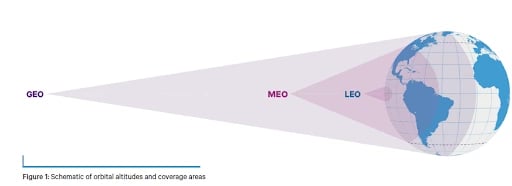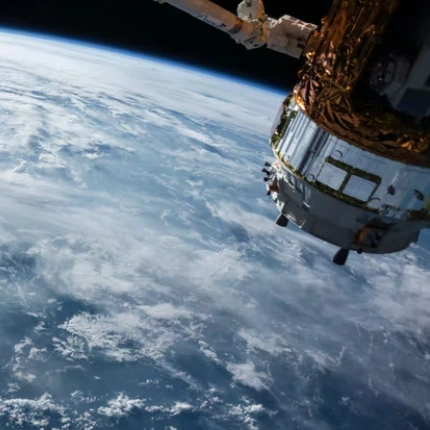Do you remember when every housetop used to have a dish pointing into the sky to receive internet from satellites? They are not as popular as they used to be. That’s because most people have begun to consume media much differently. Today, the average consumer is more interested in data. Most of that data comes from underground cables. Although internet delivered via ground-laid fiber-optical cable offers upload and download speeds faster than satellite, there is nothing fast about deploying the infrastructure necessary to get fiber to homes. Over half the planet does not have access to cables that provide reliable broadband.
That is why satellite companies still have a market to pursue. With this market growth opportunity, companies can pay for the R&D that might one day lead to broadband speeds comparable to terrestrial methods.
Different Types of Satellites
Although there are dozens of satellite styles and use cases, all satellites fall into one of three categories:
Geosynchronous Equatorial Orbit (GEO) appear fixed as they move at the same angular velocity as the Earth and orbit along a path parallel to rotation. They orbit around 36,000 kilometers, are physically the size of a school bus, and cost top dollar. These satellites cast a wide net of data. One GEO can cover most of North America, but their data capacity is limited because of their elevation. This means they suffer from lag time.
Low Earth Orbit (LEO) satellites fly much faster due to their proximity to Earth. They revolve at an altitude between 160 to 2,000 kilometers (99 to 1,200 miles). Because LEO satellites are much lower, they can provide faster speeds like 5G with lower latency. The catch is that they have a narrower signal that covers less ground. And when you have smaller beams but still want a lot of coverage, you will need an entire network of satellites to provide continuous, global coverage.
Medium Earth Orbit (MEO) Anything in-between the orbits of GEO and LEO satellites are Medium Earth Orbit MEO-satellites. MEO-satellites traditionally service maritime navigation and crew communications. Currently, they are not serving many IoT-related use-cases. That said, there is potential for tracking crates as they make their way across the oceans.

With newer satellites, companies can provide internet where current infrastructure cannot reach and expand to those unreached locations much faster.
What Does This Have to Do With IoT?
You might be asking yourself, how does all this talk about satellites relate to the Internet of Things (IoT)?
Initially, the strongest play for satellite telecommunications companies is in providing data transmission in areas terrestrial communications companies have poor coverage. With this kind of foothold, it may be possible to pursue other use cases. Satellite companies can press their advantage in information and cyber security.
While terrestrial networks can support most IoT applications, traditional network services do not reach many remote areas where IoT projects are needed. Once again, satellites win because of infrastructure constraints. Satellite communications are key to the IoRT, or Internet of Remote Things. You see their use in embedded sensor and control networks in the shipping industry, as well as oil and gas exploration and mining. With outdoor tracking, LEO satellites can even act as gateways.
Join the AirFinder Difference!
- Innovation. Organizations can be freed up to innovate and bring more impactful products and services to market.
- Profitability. Increased profitability provides new opportunities to innovate and improve valuation.
- Digital Transformation. Discover competitive advantages, new revenue opportunities, improved customer relationships and increased efficiency.
Who is Winning?
In the satellite industry, there are well-known names such as Starlink and Amazon's Project Kuiper, but there are also lesser-known ones like OneWeb and Viasat. They all have plans to launch entire fleets of satellites to provide you with internet. The problem is, there is limited space for LEO satellites. This first-mover advantage is a big deal for any company trying to sell data.
In the past, there were three different types of companies; companies that built the satellites, companies that launched the satellites, and companies that used the satellites. Today Starlink has a significant advantage because it is capable of all three.
Having access to reusable rockets is one of the reasons the Starlink network has grown rapidly. Currently, SpaceX is the only company with access to these rockets. This gives Starlink a significant advantage in this space race.
The total number of satellites in Elon Musk’s constellation is up to 1,993. He still has a way to go if he hopes to blanket the entire planet with a high-speed Wi-Fi signal. Starlink will likely need at least 10,000 satellites in orbit before it can claim to offer full service to a majority of the globe (and SpaceX has shown signs that it wants as many as 42,000 satellites in the constellation).
Per Musk, the list of countries currently serviced by the growing network of low-earth orbit satellites includes the US, Canada, the UK, France, Germany, Austria, the Netherlands, Ireland, Belgium, Switzerland, Denmark, Portugal, Australia, New Zealand, and Ukraine. The Ukraine service is brand new. Due to the war with Russia, internet service has been spotty or non-existent for the country. Since Starlink does not require a ground station to transmit data, the people of Ukraine have the ability to communicate with each other and the world.
Whether or not Starlink satellites provide a service outside the US is irrelevant. All that matters is that they can, and probably will in the future. Envision a world in which customers using a mobile phone, or clients using asset tracking, will not have to change their internet providers simply because they moved across the border.
Closing Thoughts
As of right now, the only trustworthy satellite technology is GPS. That said, GPS works best as an outdoor technology. Are you looking for a system that works both indoors and outdoors for asset tracking and monitoring in remote locations? Link Labs is the answer. With a combination of four technologies, our patented SuperTag can track your assets inside and outside the facility. If you would like to learn more, please contact us for a demo.




